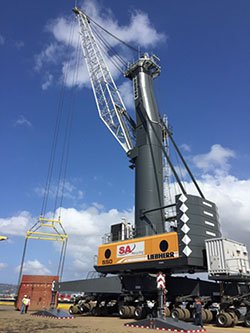Port of Los Angeles: Off-Road Heavy Duty Equipment and Infrastructure Enhancements
Electric Crane Project
Cargo handling equipment at the Port of Los Angeles is a major contributor of pollutants in the South Coast Air Basin, emitting over 500 tons of nitrogen oxides (NOx) per year. Pollution from off-road heavy duty equipment at the San Pedro Bay ports (Los Angeles and Long Beach) and the Southern California freight industry comprises over 10% of fine particulate matter (PM2.5) emissions and nearly a third of NOx emissions in the basin.
In 2014, the U.S. Environmental Protection Agency (EPA) granted a total of $1.3 million of Diesel Emission Reduction Act (DERA) funding for a new electric crane to the Los Angeles Harbor Department (LAHD). The new electric crane is the port complex’s first electric mobile ship-loading crane for non-container cargo, an important step in the port’s goal of becoming a zero-emission green port.
Project Description SA Recycling Electric Crane Exit
SA Recycling Electric Crane Exit
In December 2014, LAHD submitted a DERA application on behalf of SA Recycling. As the largest recycling operation and exporter of scrap metal in Southern California, SA Recycling diverts millions of tons of scrap material away from landfills by shipping it to various facilities in Asia, where the material is melted down and reprocessed into new items. The application proposed to replace a 1987 diesel crane with an all-electric crane. The grant was awarded to LAHD in April 2015 and the new crane was purchased later that year.
LAHD needed to electrify the wharf to power the electric crane. From January to December 2016, the wharf underwent construction and electrical upgrades. To complete construction within the project grant period, this process required coordination among the Engineering, Environmental, Planning, and Construction divisions.
Outcomes
The 1987 diesel ship-loading crane was replaced with a Liebherr 550 electric crane, reducing crane emissions by 100%. Over the course of its life, the crane will eliminate the following air pollutants as well as reducing noise:
- Nitrogen oxides (NOx)
- Particulate matter (PM)
- Hydrocarbons (HC)
- Carbon monoxide (CO)
- Greenhouse gases (GHG) and carbon dioxide (CO2)
Just the particulate matter emissions, alone, eliminated from this replacement will be equivalent to taking 3,400 heavy duty trucks off the road for a year. These pollutants can contribute to significant health problems—including premature mortality, increased hospital admissions for heart and lung disease, increased cancer risk, and increased respiratory symptoms – especially for children, the elderly, outdoor workers, and other sensitive populations.
Lessons Learned
Shore Power Projects
As part of their Goods Movement Emission Reduction Program, LAHD was awarded $23.5 million by the California Air Resources Board (CARB) in 2012 to install shore power at 10 berths, reducing diesel emissions from vessels while at port.
Other Cargo Handling Equipment Projects
Since 2008, EPA has awarded nearly $17 million in grants and has leveraged about $16 million from private and public partners through its DERA program to clean up diesel vehicles, vessels and equipment at the San Pedro Bay Ports. For example, in 2016, LAHD received $800,000 in DERA funding and $2,214,000 in matching funds from their project partners to replace 16 yard tractors with new Tier 4 models and repower 2 heavy lifts with Tier 4 engines. Each federal dollar invested in these clean diesel projects returns approximately $5 to $21 in public health benefits.
LAHD was also awarded a $731,298 Emerging Technologies grant by the EPA in 2010 for the demonstration of the Eco-Crane, a diesel-electric hybrid rubber-tired gantry crane. Additionally, LAHD has received nearly $25 million from CARB from 2012-2015 for their diesel emission reduction efforts, including $1 million awarded in 2013 as part of CARB's Air Quality Improvement Plan for the construction and demonstration of two Electric Yard Tractors.
